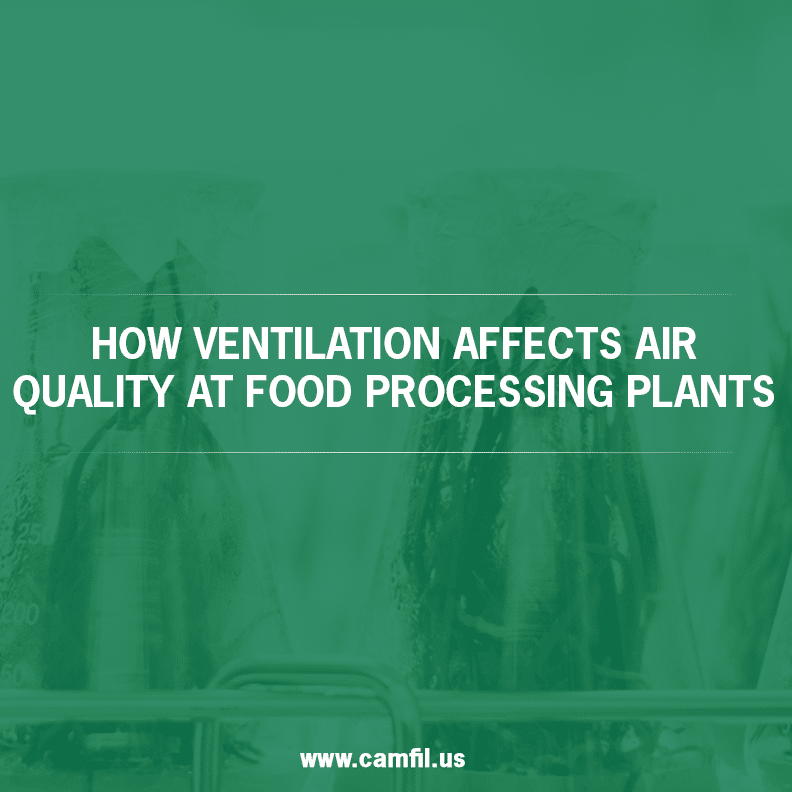New Video Update During Covid-19 Pandemic at Meat Plants
Learn about air handling at food processing plants
Studies have found that even the most efficient air-conditioning system can spew out high amounts of bacteria into an indoor facility, and when that facility is responsible for the manufacturing and packaging of food, that pollutant can create a health crisis. That’s why air quality at a food processing plant is so important, and also why it’s nearly impossible to eliminate pollutants without an effective air filtration system. Also read our previous blog post.
Best Air Filters for Food Industry
“Outdoor air can carry from 200 to 1,500 bacteria per cubic meter,” stated Mark Davidson, Camfil USA Food & Beverage Segment Manager. “That means that poorly filtered air conditioning systems can circulate as much as 15 million bacteria each hour, and that can compromise the quality of products at food processing plants. Understanding the importance of temperature, humidity and air filtration are the keys to establishing an effective air filtration strategy.”
Like cleanrooms and bio-labs where sterility is required, food-processing plants must be kept as free of pollutants as possible. Per an article on food safety, one of the most common ways that pathogens enter these facilities is through air that flows from doors and other openings.
These pollutants are known as “bioaerosols,” defined as (1) “airborne contaminants that include bacteria, fungi, viruses and pollen. These free-floating microorganisms may be present in the air as solids (dust) or as liquids (condensation and water), and they are an important bacterial vehicle.”
The problem is that there are often deficiencies and breakages within those openings that allow pollutants to enter the food processing facility.
That’s why the proper sealing of doorways and openings is one of the key factors in preventing pathogens from flowing through the facility.
Per the article, there are other issues in addition to sealing openings:
“Slow operating doors compromise quality and safety by enabling dust and fumes to travel with the forklift between areas. Slow speed can also reduce control over desired temperatures, threatening food quality. The faster a door operates, the more effective it serves as a barrier.”
The Importance of Air Flow
One of the biggest problems in a food processing facility is the constant amount of negative pressure.
That is the reason that food processing facilities must have as many as two-dozen air changes per hour.
Years ago, the U.S. Department of Agriculture had established a minimum of six air changes per hour for meat packing facilities, but that requirement was phased out. Typically, food-processing facilities need about 20 to 25 ACHs per hour to: (2)
“…remove off odors, steam and other airborne contaminants and filter them out of in the recycle process. The actual number of air turns depends on the type of processing taking place in the plant and must be designed by a competent HVAC engineer to fit the facility and the process.”
“Airflow in meat-processing plants, due to the presence of live animals, carry a high risk of airborne contaminants.”
In a piece on the Stellar Food for Thought website, design and construction expert Luke Facemyer writes: (3)
“In these facilities, the direction and frequency that air flows is especially important. The air from kill floors and rendering areas, where raw poultry and meat are handled, must never flow to areas such as packaging, where the airborne bacteria could infect the final product.”
Facemyer also writes that condensation control and temperature control must be strictly regulated to ensure the proper air balance between different areas or rooms of a food processing facility.
Condensation in particular can create moisture in “equipment crevices and on ledges,” causing the growth of bacteria and mold.
Clean Air Solutions
For more than 50 years, Camfil has made air filters for commercial facilities, including the food and beverage industry. Our range of air filtration systems is manufactured to help contain and eliminate microbiological contamination that can contaminate food and cause a public relations nightmare.
Please visit our air filters website to learn about how we design our high capacity air filters for the food and beverage industry.
Lynne Laake
Camfil USA Air Filters
T: 888.599.6620,
E:Lynne.Laake@camfil.com
F: Friend Camfil USA on Facebook
T: Follow Camfil USA on Twitter
Y: Watch Camfil Videos on YouTube
SOURCES
- http://www.foodqualityandsafety.com/article/shutting-the-door-on-pathogens/
- http://www.foodsafetymagazine.com/magazine-archive1/junejuly-2011/in-plant-air-handling-and-food-safety-there-is-a-connection/
The post How Ventilation Affects Air Quality At Food Processing Plants appeared first on Air Filters for Clean Air.

